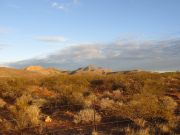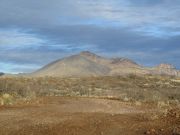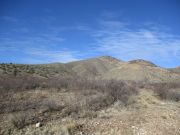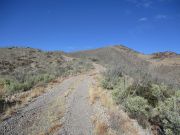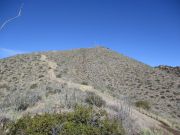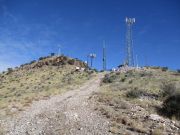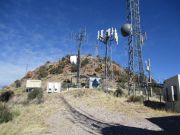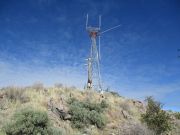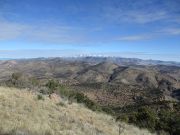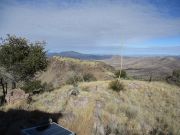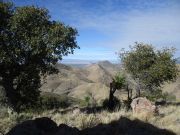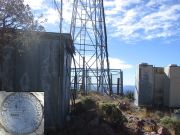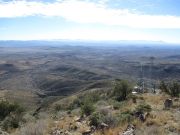
The Mountains of Arizona
• www.surgent.net
|
|
Peak 6513 Airway Beacon #22 "Bernardino" |
• Pedregosa Mountains • Arizona State Trust Lands • Coronado National Forest (summit) • Cochise County |
|
Date: February 4, 2024
• Elevation: 6,513 feet
• Prominence: 913 feet
• Distance: 5.1 miles
• Time: 3 hours, 50 minutes
• Gain: 1,730 feet
• Conditions: Cool, high clouds at first then clearing
Arizona
•
Main
•
PB
•
LoJ
•
BM Information (1957)
This peak is part of the Pedregosa Mountains, which rise south of the Chiricahua Range, north of state route AZ-80. The summit features a few modern communicatons towers and an old airway beacon, with a steep dirt track running up 1,600 vertical feet of mountainside to service the towers. From the highway, the peak is easily visible because of the track. It is also just short of being the range highpoint and is the second-most-prominent mountain in the range.
I had tired myself yesterday hiking a couple peaks by Patagonia but the weather was so nice, I wanted to get right back out and hike another peak. But I wanted something uncomplicated, no bushwhacks or endless scrambles. This peak promised an easy way up, in the sense I would still have to gain the elevation by my two feet.
I left Bisbee while still mostly dark, stopped in Douglas for snacks, and continued northeast on AZ-80 about twenty more miles into the hinterlands, the land that time forgot. I could see the peak as I drove in, that part was easy. How to get close to it would be the day's biggest challenge.
The land here is a mix of private and State Trust, with some of the roads designated as easements into the National Forest lands. Some of the landowners allow passage on the roads as part of the state Game & Fish Sportsman Access program. The summit, interestingly, lies exactly on the border of the Coronado National Forest.
I was looking for a simple road in off the highway, using nearby hills as landmarks. I overshot the turn but this turned out well anyway. I ended up turning into the next main road, signed for Boss Ranch, where I signed myself in and picked up a free ranch pass. I then returned to the road I should have turned onto, less than a mile south.
I immediately passed through a gate, going northish a few dozen yards, then a soft-left onto a gas-line track. The map and satellite images match up well and I had copies of both. This gas-line track, even on the satellite image, looked rough. Sections of it seem to be perpetually muddy and rutted, and there are drive-arounds virtually the entire way. The ground, for the most part, was solid, but I did have to ease through a couple muddy and rutted segments, much of it still wet and sticky from the storms a couple days ago. I passed a second gate at a cattle grate along this stretch.
I stayed on this gas-line road about a mile, past a corral, then turned right as the main road now headed north, almost on a direct bearing toward the peak. The road conditions improved, and I could motor along at 25-30 miles per hour. I passed a third gate about a mile in on this second road, which the maps call Dangerous Road.
I was able to cover about three or four more miles on this road, passing through three more gates along the way. Each gate had to be propped open, then I'd drive through and get out to close them. This added time. I drove to a big cleared area that was just a little too muddy for my comfort. I was close enough to the peak, so I backed into a spot off the road, put my pass in the window, got attired and started hiking at 8:20 a.m.. The day was a little cloudy, but just a sheen of high clouds, and clear on the horizons. The forecast called for a sunny day, high in the 50s. For now, it was about 40°.
I walked Dangerous Road about a mile, to a junction where a left leads to the summit tower road. I was looking at 1,590 feet of elevation gain in a mile and a half, all along this road. So I got busy walking. The grade steepened but was still lenient, about a 10% grade, just fine for walking. The tread was good, very little rubble or big rocks and ruts. I got into a slow but steady rhythm, taking little baby steps, one after another, not needing to stop at all.
About half-way up, the grade steepens, and the final third or so, the road is very steep, I'd guess about a 20-25% grade, which is noticeably steep. The tread was more haggard, more exposed rock, more rubble, so I had to move slowly. I slipped a few times but stayed upright. But the actual climbing was easy, and I was soon at the towers, having been at the hike now for 90 minutes.
The road ends on a platform amid the towers, all modern and humming. One had a sign on it reading "Bernardino". The summit, however, is another hundred feet higher up a rocky knoll, on which sits the actual airway beacon. I stashed my back on a tower's concrete footing and walked up this rocky slope, needing to work up about twenty feet of easy scrambling through the rocks. Once above the rock band, I found a path that led right to the tower.
The tower is definitely an old beacon. It has that look, and I've seen a few others in Arizona. In the old days, these beacons would have a light mounted, and a sequence of them would serve as a means of navigating at night, literally by following the lights. The tower was behind fencing and appears to still serve a purpose, possibly outfitted with some modern electronics for today's smaller-plane pilots. That's my guess.
I found the benchmark on a rock. It is not stamped with a name, but with a plus sign "+" used as a boundary marker, and an elevation (6,510 feet, said the disk). I took a few photos from this perch. The Chiricahua Mountains were covered in snow. By now, most of the clouds had moved on and I had very mild, pleasant conditions.
I walked back down to the lower towers and my backpack, then found a good rock to sit on and have a snack break. I spent about ten minutes relaxing and looking around. From my car, I had gained 1,730 feet in two and a half miles.
I enjoyed this summit. It wasn't sexy, but it was a strenuous hike and a good workout. I am too chicken to ever drive one of these roads. I can picture the vehicle's severe lean or gradient, and how uncomfortable that would be. I wouldn't recommend anything less than a robust Jeep-type vehicle on this road.
The hike out took barely over an hour. I was able to walk at a consistent rate and avoid slipping and sliding. Once back down onto Dangerous Road, I walked back to my car, three people on two quads rumbling past me with their rifles. They waved and I waved back. I was back to my car at about noon.
On the drive out, I discovered that some of the gates had been left open. I closed one, but one other was lashed in place and undoing the lash looked like a ten-minute job. Obviously, those quad people were responsible, and it bothered me that they left the gates open as they did when the signs were emphastic on every gate to keep them shut. The ones closer to the highway were shut properly. Other than that, the drive out went without issue and I was able to kick up some mud onto my car.
I was tired by now, but still curious about a couple of easy-looking volcanic mounds across the highway, roughly one or two miles east of the highway. Both roads that led in were gated and locked, so clearly, there was no way to drive in. This land is almost-contiguous State Trust and there were no signs anywhere on the fences or gates against trespassing. It would require a long walk, and I wasn't interested in doing that today. Maybe in the future. From here, I just drove back to Bisbee, arriving about an hour later.
I wanted to know more about the name "Bernardino". The topographic map shows the name along the highway as a place-name, but there is no town or even old buildings here. The Southern Pacific Railroad ran through here decades ago and Bernardino was a stop along the line. There are no tracks or traces of an old rail bed. One of the buildings on the summit had a sign "Bernardino" on it, maybe that's the name the tower people use to refer to the site, which would make sense.
The San Bernardino Valley is the big valley east of the Pedregosas, extending almost to the New Mexico line. This is a volcanic field too, with a couple dozen cinder mounds and at least one very large maar crater. I would love to explore the volcanic field but it appears road access is throttled. Web searches invariably bring us the San Bernardino in Calfornia. There just isn't much on the web about this particular Bernardino (it does not use the "San" except for the reference of the Valley).
The couple of sites that I reference regarding benchmarks and airway beacons also overlook this particular beacon. There's another old airway beacon site atop a hill about ten miles north. I could find just a single document from 1957 mentioning this beacon. They call it Airway Beacon #22.
|
|
